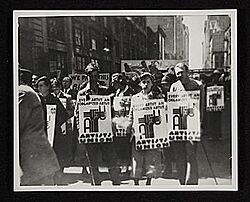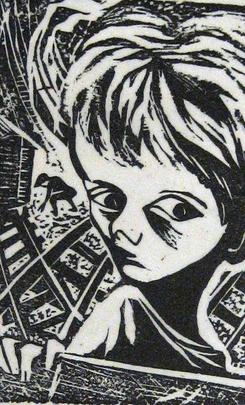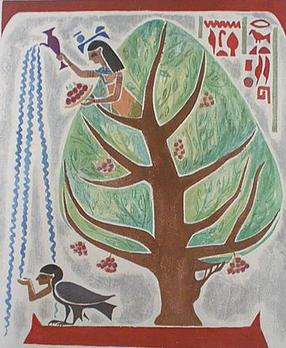Winifred Milius Lubell facts for kids
Quick facts for kids
Winifred Milius Lubell
|
|
|---|---|

Union members rally for awareness. From left to right: Edward "Deyo" Jacobs, Winifred Milius, and Hugh Miller. Photograph by Irving Marantz. From the Archives of American Art
|
|
| Born | June 14, 1914 New York City, United States
|
| Died | January 3, 2012 (aged 97) Provincetown, Massachusetts
|
| Education | Art Students League of New York Duncan Phillips Museum School |
| Known for | Illustrator writer |
Winifred Milius Lubell (born June 14, 1914 – died January 3, 2012) was an American artist, illustrator, and writer. She was known for her detailed drawings and for writing many books. In her younger years, Winifred was very involved in fighting for social justice and helping people.
She started her art career by drawing people who were struggling during the Great Depression. This was a time when many people lost their jobs and homes. Later, she used woodcuts to show the difficulties faced by working-class people in Eastern United States. She also drew scenes from important worker strikes in Chicago. One of her most famous works includes the illustrations for The Outer Lands, a nature book about Cape Cod. Winifred Milius Lubell passed away at the age of 97.
Contents
Winifred's Early Life and Education
Winifred Milius Lubell was born in New York City. Her parents, Elsa Simonson and Lester Milius, came from wealthy families. Her ancestors had moved to the United States from Germany in the 1800s. They made a lot of money from real estate and textiles in Manhattan.
Winifred grew up in a German-Jewish family. Her parents cared a lot about their social standing. However, her mother, Elsa, was more open-minded. Elsa was also the younger sister of a famous theater designer named Lee Simonson. Because of her mother, Winifred grew up around many modernist artists.
From 1922 to 1932, Winifred went to the Ethical Culture Fieldston School. This school taught ideas like racial equality, social justice, and thinking freely. These ideas were different from her father's views. Her time at Fieldston helped her become a "rebel" who spoke out against unfair rules for rich people.
Her Artistic Journey Begins
Winifred's mother, Elsa, was an amateur painter. She had a large art studio where Winifred first started exploring art. Elsa even had her own art shows in the 1920s. However, she stopped painting in 1928 due to Parkinson's disease.
After her mother died in 1933, Winifred became more serious about art. She first joined the National Academy of Design to learn figure drawing. But she found the school too strict. An instructor told her to focus on drawing plaster casts to make her drawings more "dignified." Winifred disagreed and left the school.
Instead, she joined the Art Students League of New York. Here, students could choose their own classes. In 1934, she took a life drawing class with artist George Grosz. She liked Grosz because he had leftist ideas and new ways of drawing. Grosz took his students on trips to Hoovervilles. These were shantytowns where homeless people lived during the Great Depression. Winifred and her classmates drew the struggles of these people. These sketches later became prints.
Art for Social Change
Winifred felt that Grosz wasn't political enough. So, she started learning from printmaker Harry Sternberg. She called him a "spirited leftist." Sternberg was part of the John Reed Club, a group with Marxist beliefs. His ideas influenced Winifred and her friends.
Sternberg encouraged his students to join the Artists Union in New York. Winifred showed her art in union shows. She also joined protests, like the one against the destruction of Diego Rivera's painting Man at the Crossroads at Rockefeller Center. With her friends, she often visited art galleries and museums.
Winifred and her friend Blanche Grambs explored different parts of New York City. They drew outside or went to the New York Public Library on cold days. Winifred's drawings of the library showed it as a shelter for people affected by the Depression. They also used unemployed men from Stuyvesant Square as models for their portraits. These drawings showed the problems of Capitalism and the strength of working people.
Winifred's first published drawing was a pen-and-ink drawing of children in her neighborhood. It appeared in The New Masses, a Marxist publication.
Drawing Industrial Life
After two years, Winifred started drawing industrial themes. In 1936, Harry Sternberg received a special award to travel to mining and steelmaking towns. He took Winifred and other students with him. They visited an anthracite mining town in Lanford, Pennsylvania.
Winifred was deeply moved by the poverty she saw there. She stayed with a family and noticed how malnourished they were. Her woodcut called Coal Gatherers shows children picking up small pieces of coal from train tracks. They would take these home for fuel. This artwork aimed to show people the struggles of miners. It was part of a big art show called "America Today" in 1936. The show wanted to raise awareness about social issues and make art available to many people.
Life and Art in Chicago
At the end of 1936, Winifred moved to Chicago with her first husband, Daniel House. He was studying law at the University of Chicago. Winifred joined the Chicago branch of the Artists Union. She became involved in a dispute against the Illinois Art Project (IAP). This project was criticized for firing artists and censoring their work.
On December 12, 1936, Winifred joined a sitdown strike at the IAP headquarters. This protest lasted eight days. Her drawings of the event were published in the Chicago Daily News and New Masses.
In 1937, Winifred became even more active in the labor movement. She helped Harry Sternberg paint a mural for a post office in Lakeview, Illinois. They visited stockyards and worker neighborhoods for inspiration. Winifred also helped the Packinghouse Workers Organizing Committee by painting banners and creating illustrations for their leaflets.

Winifred's strong involvement with the Communist Party caused problems with her husband, Daniel. He had different political views. They separated within two years, and Winifred moved back to New York.
Returning to the East Coast
Back in New York in 1938, Winifred started working in theater. She designed costumes for a modern dance performance that raised money for a trade union leader. She also designed costumes for a musical about American history, including events like the Boston Tea Party. However, she stopped designing costumes after 1939.
Winifred started spending time at a studio shared by other artists. There, she met Cecil Lubell. He was a Harvard graduate who studied writers like William Blake. Cecil later became an expert on textiles and wrote many books about them. Winifred and Cecil had similar beliefs, especially about the Communist Party trying to solve society's problems.
They married in Boston in 1939 and moved to Croton-on-Hudson, New York. Soon after, they worked together on a book called Petticoat Picket Lines: The History of Women in the American Labor Movement. Cecil wrote it, and Winifred illustrated it. But the book was never published because World War II began. Winifred continued to create woodcuts that explored themes of gender, race, and class. These artworks showed the lives of black women who were abolitionists.
After World War II
Winifred and Cecil Lubell remained involved with the Communist Party for some time. However, they and their family were affected by the Red Scare during the Cold War. This was a time when people in the U.S. were very afraid of Communism. In 1956, Cecil Lubell was called to testify against a friend. He refused to say anything that would harm his friend.
During this time, Winifred began illustrating more books. She and Cecil worked together on many children's books about animals, natural history, plants, and ecosystems.
Winifred's Political Activities
Winifred was active in groups like the Artists Union and the American Artists' Congress. She was also a member of the Communist Party of America. During the Great Depression, she supported government help for the arts. She also helped the Congress of Industrial Organizations create labor unions that included all races. She supported the Loyalists in the Spanish Civil War.
Winifred became active in politics during her college years, inspired by her professor Harry Sternberg. She had close artist friends who also joined leftist politics. She once said that finding Communism in the early 1930s felt like an "absolutely wonderful thing."
While in Chicago, she became very involved in the organized labor movement. She also helped raise awareness about the Loyalists fighting against Francisco Franco in Spain. Her block prints were included in a book called For Spain and Liberty. In it, she wrote about standing together with everyone who fought against forces that "burned books in Germany, plundered Ethiopia, made shambles of Guernica, and everywhere imperil the minority peoples of the earth."
Even in 2005, Winifred still believed in the ideals of Communism. She never regretted her involvement. She said it helped her understand the world's many different and complex issues.
In the 1970s, after moving to Wellfleet, Massachusetts, Winifred and Cecil started a local chapter of Amnesty International. They also actively supported the Wellfleet Public Library.
Winifred as a Writer
Starting in the 1940s, Winifred wrote or illustrated over 50 books. When she was in her late seventies, she learned ancient Greek. In her eighties, she even translated an ancient Greek poem called Batrachomyomachia.
Winifred's Legacy and Family
In 1995, some of Winifred's illustrations and sketches were given to the Andersen Library at the University of Minnesota. In 2003, she donated her personal papers to the Archives of American Art. After she passed away, her children's book materials went to the Kerlan Collection in Minnesota. Her artwork and wood blocks were given to the Rutgers University Libraries.
In 1935, Winifred married her first husband, Daniel House. They lived in Chicago and divorced in 1938. In 1939, she met and married her second husband, Cecil Lubell (1912–2000). Cecil was a writer and textile expert from England. They shared interests in mythology, psychology, and languages.
Winifred and Cecil had two sons: David (born 1942), who became an archaeologist, and Stephen (born 1945), who became a typographer. They also had five grandchildren and two great-grandchildren.



